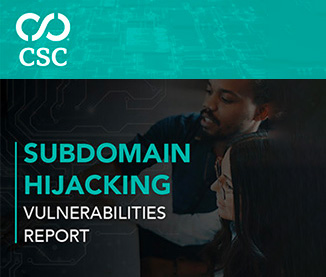

Brand Protection |
Sponsored by |

|



 I was in a conversation with a close friend the other day, you know the kind where you have been friends for so long that you have endured each other experimenting with changed politics, evolving religion, and if you are unlucky, flirtations with multilevel marketing. We were discussing politics that day, which is not unusual given our ancient friendship and the recent change at the helm of the United States. more
I was in a conversation with a close friend the other day, you know the kind where you have been friends for so long that you have endured each other experimenting with changed politics, evolving religion, and if you are unlucky, flirtations with multilevel marketing. We were discussing politics that day, which is not unusual given our ancient friendship and the recent change at the helm of the United States. more
 For years, the question of exactly when to register a domain name has been one asked by legal departments, as they've sought to formalize their internal processes. If you were to think about it logically, it would make most sense to register it after the trademark had been cleared. After all, why bother to register a domain, if you aren't going to use it to support a product, service or campaign? more
For years, the question of exactly when to register a domain name has been one asked by legal departments, as they've sought to formalize their internal processes. If you were to think about it logically, it would make most sense to register it after the trademark had been cleared. After all, why bother to register a domain, if you aren't going to use it to support a product, service or campaign? more
 Too many techies still don't understand the concept of due process, and opportunistic law enforcement agencies, who tend to view due process constraints as an inconvenience, are very happy to take advantage of that. That's the lesson to draw from Verisign's proposal and sudden withdrawal of a new "domain name anti-abuse policy" yesterday. The proposal, which seems to have been intended as a new service to registrars, would have allowed Verisign to perform malware scans on all .com, .net, and .name domain names quarterly when registrars agreed to let them do it. more
Too many techies still don't understand the concept of due process, and opportunistic law enforcement agencies, who tend to view due process constraints as an inconvenience, are very happy to take advantage of that. That's the lesson to draw from Verisign's proposal and sudden withdrawal of a new "domain name anti-abuse policy" yesterday. The proposal, which seems to have been intended as a new service to registrars, would have allowed Verisign to perform malware scans on all .com, .net, and .name domain names quarterly when registrars agreed to let them do it. more
 The public policy objectives in the area of content filtering and blocking space are intended to fulfil certain public policy objectives by preventing users within a country from accessing certain online content. The motives for such public policies vary from a desire to uphold societal values through to concessions made to copyright holders to deter the circulation of unauthorised redistribution of content. more
The public policy objectives in the area of content filtering and blocking space are intended to fulfil certain public policy objectives by preventing users within a country from accessing certain online content. The motives for such public policies vary from a desire to uphold societal values through to concessions made to copyright holders to deter the circulation of unauthorised redistribution of content. more
 There are predatory-domain name registrants, and there are registrants engaged in the legitimate business of acquiring, monetizing and reselling domain names. That there are more of the first than the second is evident from proceedings under the Uniform Domain Name Dispute Resolution Policy (UDRP). "Given the human capacity for mischief in all its forms, the Policy sensibly takes an open-ended approach to bad faith, listing some examples without attempting to enumerate all its varieties exhaustively. more
There are predatory-domain name registrants, and there are registrants engaged in the legitimate business of acquiring, monetizing and reselling domain names. That there are more of the first than the second is evident from proceedings under the Uniform Domain Name Dispute Resolution Policy (UDRP). "Given the human capacity for mischief in all its forms, the Policy sensibly takes an open-ended approach to bad faith, listing some examples without attempting to enumerate all its varieties exhaustively. more
In a letter released on Monday, the Internet Society Board of Trustees has expressed concern with a number of U.S. legislative proposals that would mandate DNS blocking and filtering by ISPs to protect the interests of copyright holders. "Policies mandating DNS filtering undermine the open architecture of the Internet and raise human rights and freedom of expression concerns," says Internet Society (ISOC). more
 A few days ago I wrote about a piece of my intellectual property, an article I wrote and posted on DaileyMuse.com, being stolen, plagiarized, and posted on another web site under a different authors name. I hadn't been looking for my work elsewhere, I was simply browsing the access logs and visiting other websites that stood out. As a result of finding my work posted elsewhere without my permission, I contacted the owner of the website by email and provided 24 hours to remove the content before I pursued legal action. more
A few days ago I wrote about a piece of my intellectual property, an article I wrote and posted on DaileyMuse.com, being stolen, plagiarized, and posted on another web site under a different authors name. I hadn't been looking for my work elsewhere, I was simply browsing the access logs and visiting other websites that stood out. As a result of finding my work posted elsewhere without my permission, I contacted the owner of the website by email and provided 24 hours to remove the content before I pursued legal action. more
 Come join the discussion on Wednesday 17:15 UTC. Quis custodiet ipsos custodes? As ICANN approaches its 18th birthday, it marks its ascension to adulthood and independence with a new framework of accountability. As we attempt to modernize and empower the organization with oversight of the DNS, the question of "who watches the watchmen?" is on the tip of everyone's tongue. more
Come join the discussion on Wednesday 17:15 UTC. Quis custodiet ipsos custodes? As ICANN approaches its 18th birthday, it marks its ascension to adulthood and independence with a new framework of accountability. As we attempt to modernize and empower the organization with oversight of the DNS, the question of "who watches the watchmen?" is on the tip of everyone's tongue. more
 ICANN has been sent a letter by the European Data Protection Supervisor calling them out with respect to both data collection, retention and privacy within the context of the 2013 Registrar contract (RAA). The letter is the first instance of one, to my knowledge, which makes reference to the ECJ's recent ruling that rendered the data retention directive null and void. more
ICANN has been sent a letter by the European Data Protection Supervisor calling them out with respect to both data collection, retention and privacy within the context of the 2013 Registrar contract (RAA). The letter is the first instance of one, to my knowledge, which makes reference to the ECJ's recent ruling that rendered the data retention directive null and void. more
WIPO's Arbitration and Mediation Center earlier this month became the only non-Chinese entity to provide domain name dispute resolution services for the .CN and .?? (China) country code Top-Level Domain (ccTLD). more
 Every time I see a federal appellate opinion on domain names, I'm vaguely reminded of the Country Joe song I-Feel-Like-I'm-Fixin'-To-Die Rag, whose course goes "And it's one, two, three, what are we fighting for?" Fortunately, domain name disputes do not lead to the senseless loss of life we experienced from the Vietnam War. Unfortunately, lengthy domain name litigation usually has little more strategic value. more
Every time I see a federal appellate opinion on domain names, I'm vaguely reminded of the Country Joe song I-Feel-Like-I'm-Fixin'-To-Die Rag, whose course goes "And it's one, two, three, what are we fighting for?" Fortunately, domain name disputes do not lead to the senseless loss of life we experienced from the Vietnam War. Unfortunately, lengthy domain name litigation usually has little more strategic value. more
 When applying for a new gTLD, what happens if two applications for the same extension are a city and a family name? Which one wins? Let's imagine that a person whose family name is "Marseille" applied for the .MARSEILLE new gTLD in the next round of the ICANN new gTLD program. What if there was a .MARSEILLE new gTLD too but as the name of the French city? more
When applying for a new gTLD, what happens if two applications for the same extension are a city and a family name? Which one wins? Let's imagine that a person whose family name is "Marseille" applied for the .MARSEILLE new gTLD in the next round of the ICANN new gTLD program. What if there was a .MARSEILLE new gTLD too but as the name of the French city? more
 This case had a bit of a weird result -- even though the brand owner had a mark that was 20 years old, and the alleged cybersquatter, in the meantime, acquired a domain name on the open market identical to that mark, because the domain name was first registered (by an unrelated party) before the brand owner's trademark rights arose, there was no relief under federal trademark law. more
This case had a bit of a weird result -- even though the brand owner had a mark that was 20 years old, and the alleged cybersquatter, in the meantime, acquired a domain name on the open market identical to that mark, because the domain name was first registered (by an unrelated party) before the brand owner's trademark rights arose, there was no relief under federal trademark law. more
 The Recording Industry Association of America (RIAA) has been taking a lot of people to court -- basically, harassing folks in an attempt to curb file-sharing. The $220,000 verdict against Jammy Thomas got a lot of news (and probably worried a lot of folks). However, on appeal (i.e., after a new court not cherry-picked by the RIAA to try the case looked things over), the RIAA lost... again. ...At its heart, the verdict reaffirms that simply making a copyrighted work available is not the same as actually distributing the work. more
The Recording Industry Association of America (RIAA) has been taking a lot of people to court -- basically, harassing folks in an attempt to curb file-sharing. The $220,000 verdict against Jammy Thomas got a lot of news (and probably worried a lot of folks). However, on appeal (i.e., after a new court not cherry-picked by the RIAA to try the case looked things over), the RIAA lost... again. ...At its heart, the verdict reaffirms that simply making a copyrighted work available is not the same as actually distributing the work. more
 The Uniform Domain Name Dispute Resolution Policy (UDRP) is a rights protection mechanism crafted by the World Intellectual Property Organization (WIPO) and adopted by the Internet Corporation for Assigned Names and Numbers (ICANN) for trademark owners to challenge the lawfulness of domain name registrations. Cybersquatting or abusive registration is a lesser included tort of trademark infringement, and although the UDRP forum is not a trademark court, as such, in some ways it is since it empowers (assuming the right alignment of facts) to divest registrants of domain names that infringe a complainant's trademark rights. more
The Uniform Domain Name Dispute Resolution Policy (UDRP) is a rights protection mechanism crafted by the World Intellectual Property Organization (WIPO) and adopted by the Internet Corporation for Assigned Names and Numbers (ICANN) for trademark owners to challenge the lawfulness of domain name registrations. Cybersquatting or abusive registration is a lesser included tort of trademark infringement, and although the UDRP forum is not a trademark court, as such, in some ways it is since it empowers (assuming the right alignment of facts) to divest registrants of domain names that infringe a complainant's trademark rights. more